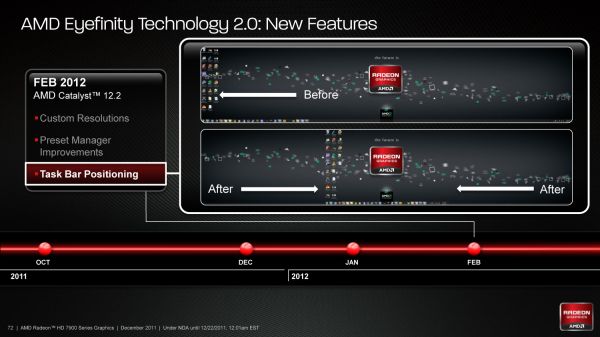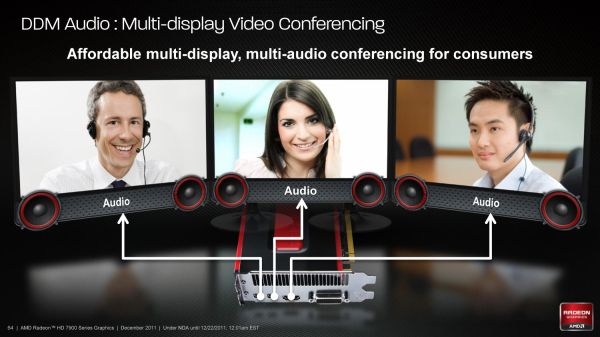AMD Radeon HD 7970 Review: 28nm And Graphics Core Next, Together As One
by Ryan Smith on December 22, 2011 12:00 AM EST- Posted in
- GPUs
- AMD
- Radeon
- ATI
- Radeon HD 7000
Display Tech: HD3D Eyefinity, MST Hubs, & DDM Audio
With the launch of the HD 5000 series back in 2009 AMD managed to get the drop on everyone, press and NVIDIA alike. Eyefinity, AMD’s Single Large Surface technology, came out of virtually nowhere thanks to a carefully orchestrated development plan that ensured very few people even within AMD knew about it. As a result of everything that was leaked ahead of time Eyefinity was not, making it AMD’s big eye catcher for the 5000 series.
As what was to be the first piece of the much dreamed about holodeck, AMD has been steadily working on it since 2009 in order to improve the experience even within their existing hardware by adding support for such features as bezel compensation and combining CrossFire with Eyefinity. For AMD it’s a feature of great importance even if end user adoption is still limited.
For the Southern Islands family AMD isn’t going to be pulling quite the rabbit out of their hat this time when it comes to displays. Southern Islands’ new display feature will be Discrete Digital Multi-Point Audio (which we’ll get to in a moment), but this doesn’t mean that AMD hasn’t continued to work on Eyefinity. Since October AMD has been engaged in an initiative they’re calling “Eyefinity Technology 2.0”, which is going to be pushed as a big part of the Southern Islands launch even though these are software improvements that will benefit all cards.
So what is Eyefinity Technology 2.0 composed of? We’ve already seen several new features starting with Catalyst 11.10, such as 5x1 portrait and landscape support and flexible bezel compensation support. The next step is going to be integrating Stereo 3D (or as AMD likes to call it, HD3D) into the mix, similar to how NVIDIA has 3D Vision Surround. Catalyst 11.12 introduced the ability to use HD3D with an Eyefinity display setup, and Catalyst 12.1 (preview out now) added support to do that in a CrossFire configuration. The final step is going to be with Catalyst 12.2 in February, which will add support for custom resolutions and the ability to relocate the Windows task bar to an arbitrary screen, two features that users have been asking about for quite some time. Again, all of these improvements are driver side, but they are a major component of AMD’s marketing for Southern Islands.
Speaking about Eyefinity, one issue that comes up time and time again is Multi Stream Transport (MST) hubs. We were introduced to MST hubs back with the launch of the 6800 series, which allowed a single DP 1.2 port to drive up to 4 monitors by taking advantage of the high bandwidth of DP1.2 and embedding transport streams for several monitors into the signal. The purpose of MST hubs was so that users could use several monitors with a regular Radeon card, rather than needing an exotic all-DisplayPort “Eyefinity edition” card as they need now.
But as many of you have asked me about, several deadlines for MST hubs have come and gone, including the latest deadline which was supposed to be by the end of this year. As with active DP adaptors this is largely out of AMD’s hands since they don’t produce the hardware, but they have been continuing to prod their partners on the issue. The latest deadline from AMD isn’t rosy – summer of 2012 – but they seem more confident of this deadline than deadlines in the past. Not that another half-year wait will be of any comfort for users who have been looking for MST hubs for the better part of the year, but at least it provides some idea on when to expect them.
Last, but certainly not least on the display technologies front is AMD’s new feature for Southern Islands, Discrete Digital Multi-Point Audio (DDMA). It’s a mouthful of a name but the concept is rather simple: it’s the next step in audio output from a video card. Video cards have been able to output audio for a few years now via HDMI, and more recently DisplayPort gained the ability. However GPUs have been limited to streaming audio to a single device, be it a monitor, TV, or receiver. With DDMA GPUs can send audio to multiple devices, and AMD is looking at how to put that ability to work.
The most basic use for being able to send audio to multiple devices is to individually address the speakers of each device, which is the cornerstone of AMD’s proposed use cases. Fundamentally AMD is looking at applications that involve matching audio streams to the monitor the relevant application is on – move a video player from your center monitor to your left monitor, and the audio from that video player should also move from the speakers on the middle monitor to the speakers on the left monitor. What can you do with speakers that are mapped to monitors? That’s what AMD wants to find out.
Being realistic for a moment, the 7970 isn’t going to be the card that sells this feature, as it’s a $550 gamer video card. Gamers are using dedicated 2.1/5.1/7.1 audio systems or headphones for surround sound, and while AMD does have a proposed multi-tasking use case for this it’s not very convincing. DDMA will become much more important on future lower end cards as those are the cards that go into family desktops, workstations, and the like. Thus the killer app for this feature (and certainly AMD’s best prepared scenario) is for video conferencing where each attendee is mapped to a monitor, and with DDMA a set of speakers on that monitor. AMD’s partner Oovoo is working on just such a system though it’s still early in development.












292 Comments
View All Comments
RussianSensation - Thursday, December 22, 2011 - link
That's not what the review says. The review clearly explains that it's the best single-GPU for gaming. There is nothing biased about not being mind-blown by having a card that's only 25% faster than GTX580 and 37% faster than HD6970 on average, considering this is a brand new 28nm node. Name a single generation where AMD's next generation card improved performance so little since Radeon 8500?There isn't any!
SlyNine - Friday, December 23, 2011 - link
2900XT ? But I Don't remember if that was a new node and what the % of improvement was beyond the 1950XT.But still this is a 500$ card, and I don't think its what we have come to expect from a new node and generation of card. However some people seem more then happy with it, Guess they don't remember the 9700PRO days.
takeulo - Thursday, December 22, 2011 - link
as ive read the review this is not a disappointment infact its only a single gpu card but it toughly competing or nearly chasing with the dual gpu's graphics card like 6990 and gtx 590 performance...imagine that 7970 is also a dual gpu?? it will tottally dominate the rest... sorry for my bad english..
eastyy - Thursday, December 22, 2011 - link
the price vs performance is the most important thing for me at the moment i have a 460 that cost me about £160 at the time and that was a few years ago...seems like the cards now for the same price dont really give that much of a increaseMorg. - Thursday, December 22, 2011 - link
What seems unclear to the writer here is that in fact 6-series AMD was better in single GPU than nVidia.Like miles better.
First, the stock 6970 was within 5% of the gtx580 at high resolutions (and excuse me, but if you like a 500 bucks graphics board with a 100 bucks screen ... not my problem -- ).
Second, if you put a 6970 OC'd at GTX580 TDP ... the GTX580 is easily 10% slower.
So overall . seriously ... wake the f* up ?
The only thing nVidia won at with fermi series 2 (gtx5xx) is making the most expensive highest TDP single GPU card. It wasn't faster, they just picked a price point AMD would never target .. and they got i .. wonderful.
However, AMD raped nVidia all the way in perf/watt/dollar as they did with Intel in the Server CPU space since Opteron Istanbul ...
If people like you stopped spouting random crap, companies like AMD would stand a chance of getting the market share their products deserve (sure their drivers are made of shit).
Leyawiin - Thursday, December 22, 2011 - link
The HD 7970 is a fantastic card (and I can't wait to see the rest of the line), but the GTX 580 was indisputably better than the HD 6970. Stock or OC'd (for both).Morg. - Friday, December 23, 2011 - link
Considering TDP, price and all - no.The 6970 lost maximum 5% to the GTX580 above full HD, and the bigger the resolution, the smaller the GTX advantage.
Every benchmark is skewed, but you should try interpreting rather than just reading the conclusion --
Keep in mind the GTX580 die size is 530mm² whereas the 6970 is 380mm²
Factor that in, aim for the same TDP on both cards . and believe me .. the GTX580 was a complete total failure, and a total loss above full HD.
Yes it WAS the biggest single GPU of its time . but not the best.
RussianSensation - Thursday, December 22, 2011 - link
Your post is ill-informed.When GTX580 and HD6970 are both overclocked, it's not even close. GTX580 destroyed it.
http://www.xbitlabs.com/articles/graphics/display/...
HD6950 was an amazing value card for AMD this generation, but HD6970 was nothing special vs. GTX570. GTX580 was overpriced for the performance over even $370 factory preoverclocked GTX570 cards (such as the almost eerily similar in performance EVGA 797mhz GTX570 card for $369).
All in all, GTX460 ~ HD6850, GTX560 ~ HD6870, GTX560 Ti ~ HD6950, GTX570 ~ HD6970. The only card that had really poor value was GTX580. Of course if you overclocked it, it was a good deal faster than the 6970 that scaled poorly with overclocking.
Morg. - Friday, December 23, 2011 - link
I believe you don't get what I said :AT THE SAME TDP, THE HD6xxx TOTALLY DESTROYED THE GTX 5xx
THAT MEANS : the amd gpu was better even though AMD decided to sell it at a TDP / price point that made it cheaper and less performing than the GTX 5xx
The "destroyed it" statement is full HD resolution only . which is dumb . I wouldn't ever get a top graphics board to just stick with full HD and a cheap monitor.
Peichen - Friday, December 23, 2011 - link
According to your argument, all we'd ever need is IGP because no stand-alone card can compete with IGP at the same TDP / price point.